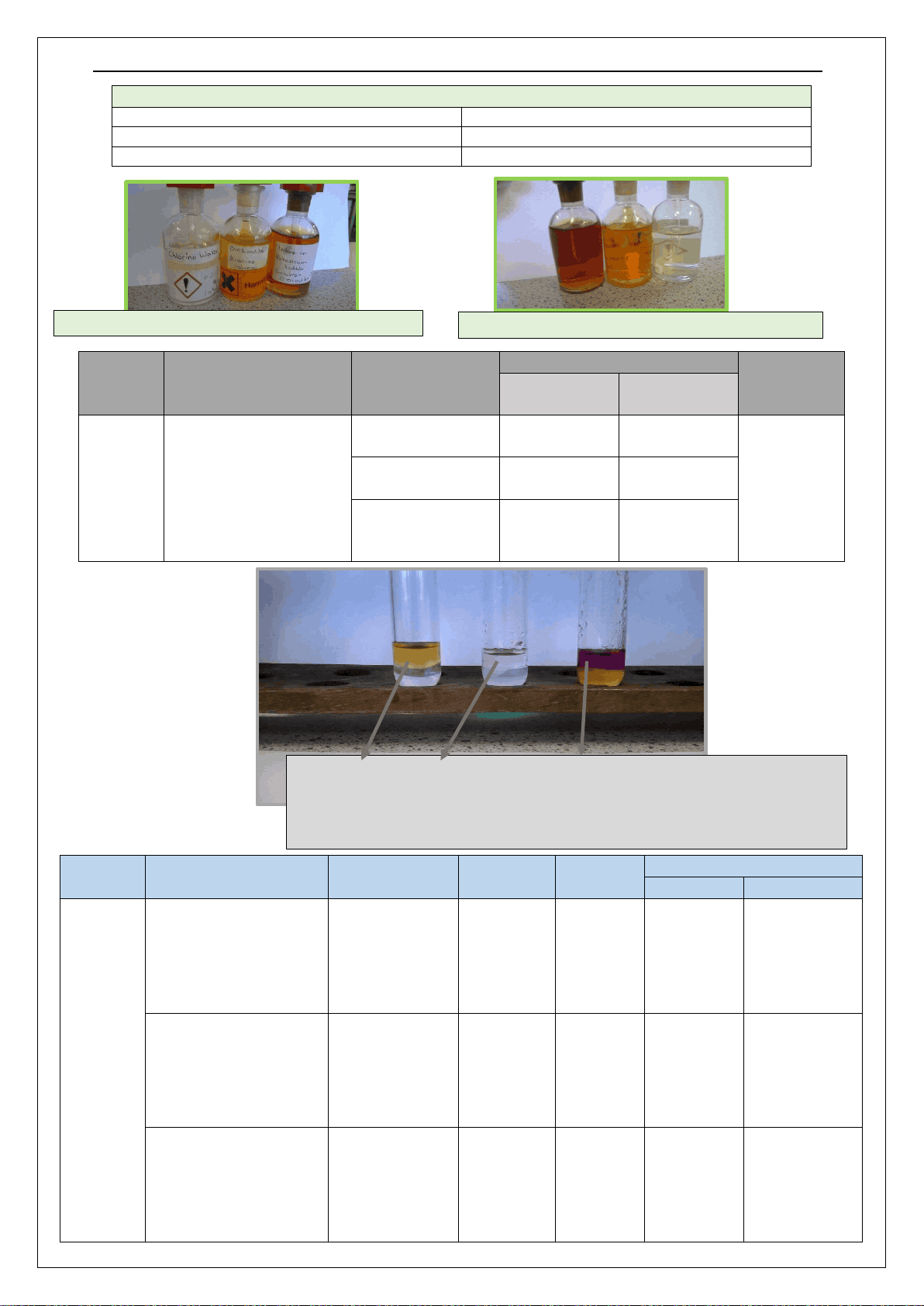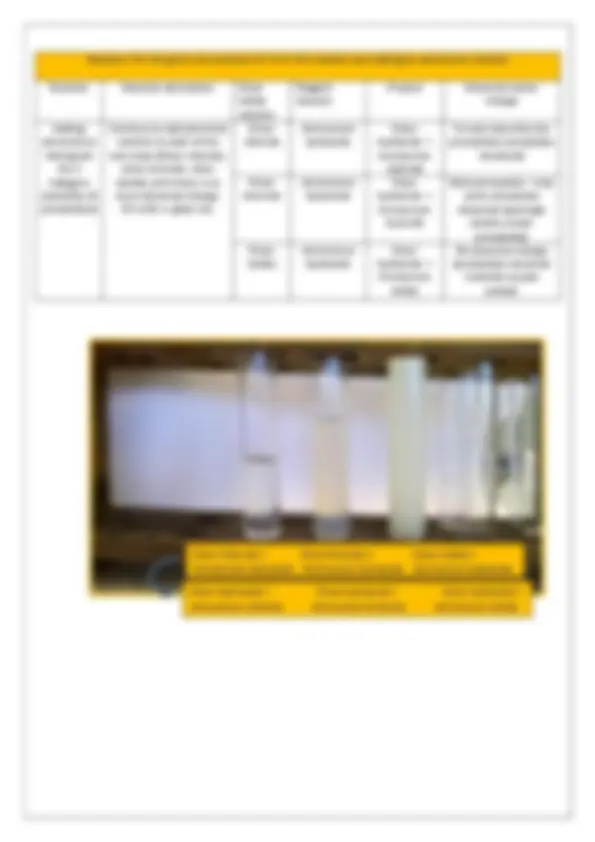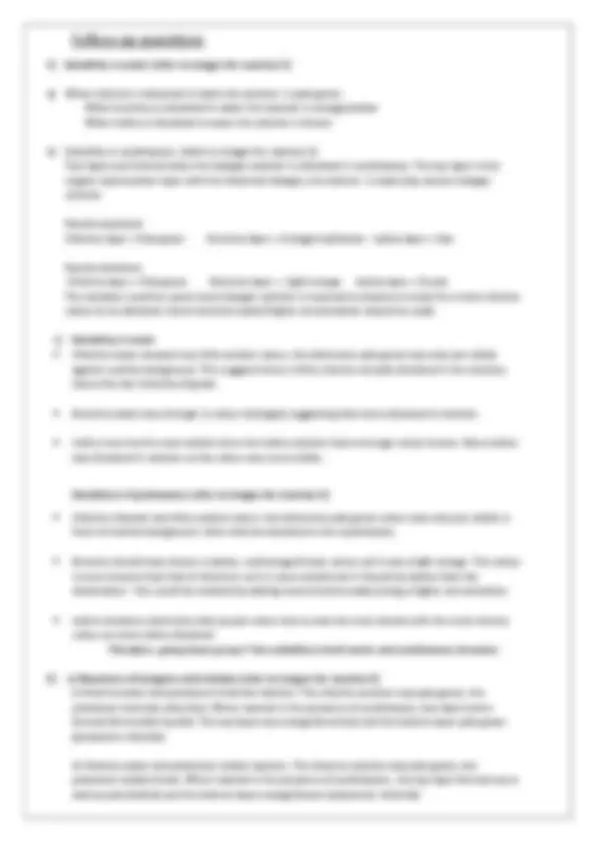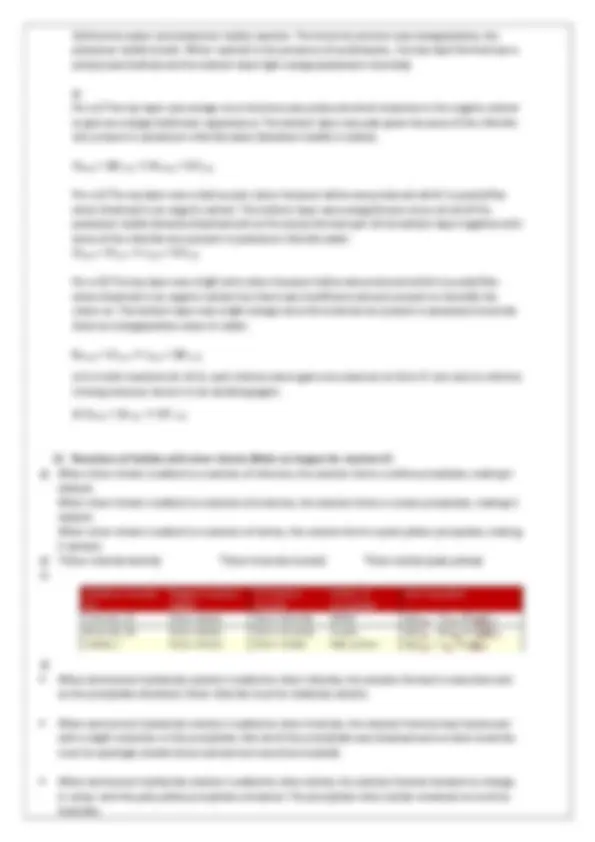





Study with the several resources on Docsity

Earn points by helping other students or get them with a premium plan


Prepare for your exams
Study with the several resources on Docsity

Earn points to download
Earn points by helping other students or get them with a premium plan
Community
Ask the community for help and clear up your study doubts
Discover the best universities in your country according to Docsity users
Free resources
Download our free guides on studying techniques, anxiety management strategies, and thesis advice from Docsity tutors
2) a) Reactions of halogens with halides (refer to images for reaction 3) i) Chlorine water and potassium bromide reaction: The chlorine solution was pale green ...
Typology: Study notes
1 / 5

This page cannot be seen from the preview
Don't miss anything!




Bromine Chlorine Iodine
(solutions dissolved in cyclohexane), top layer = organic layer with halogen Bottom layer = water/excess halogen solution
Appearance when dissolved in water Chlorine Pale green Bromine Orange/Yellow Iodine Brown
Reaction 1
Reaction description Chemical dissolved in cyclohexane
Observations of colour Other Top layer Bottom layer observations
The solubility of halogens in water
0.5cm^3 of each halogen was placed into separate test tubes. 0.5cm^3 of cyclohexane was then added to each test tube. The solution was shaken well
1 – Chlorine water Pale green Colourless All reactions formed immiscible liquids separating into layers
2 – Bromine water Orange Colourless
3 – Iodine solution Violet Orange/yellow
Reaction 2
Reaction description Halogen in solution
Halide Solution
Product Colour observation Top Layer Bottom Layer The reaction of halogens with halides
A few drops of chlorine water was added to both 0.5cm^3 potassium bromide and 0.5cm^3 of cyclohexane solution and the test tube shaken well.
Chlorine (Pale green)
Potassium bromide (colourless)
Potassium chloride + Bromine
Orange Pale green
A few drops of chlorine water was added to both 0.5cm^3 potassium iodide and 0.5cm^3 of cyclohexane solution and the test tube shaken well.
Chlorine (Pale green)
Potassium iodide (brown)
Potassium chloride + Iodine
Violet Orange/brown
A few drops of bromine water was added to both 0.5cm^3 potassium iodide and 0.5cm^3 of cyclohexane solution and the test tube shaken well.
Bromine (Orange/yellow)
Potassium iodide (brown)
Potassium bromide + Iodine
Purple/pink Pale yellow
Chlorine water, Bromine water, Iodide in potassium iodide solution (^) Iodide in potassium iodide solution, Bromine water, Chlorine water
Reaction A Reaction description Halide Solution
Reagent solution
Product Observed colour change
The reaction halide ions with silver nitrate ions
A few drops of silver nitrate solution added to 0.5cm^3 of potassium chloride solution.
Potassium chloride
Silver nitrate Silver chloride
Turned from colourless to white ( White precipitate)
A few drops of silver nitrate solution added to 0.5cm^3 of potassium bromide solution.
Potassium bromide
Silver nitrate Silver bromide
Turned from colourless to cream (cream precipitate)
A few drops of silver nitrate solution added to 0.5cm^3 of potassium iodide solution.
Potassium iodide
Silver nitrate Silver iodide + Potassium nitrate
Turned from colourless to pale yellow (pale yellow precipitate)
Chlorine & Chlorine & Bromine & Potassium bromide Potassium iodide Potassium iodide
(All in mixed with cyclohexane)
Potassium chloride (B) Potassium chloride (B) Potassium bromide (B) Bromine(T) + Iodine (T) + Iodine (T)
Silver Chloride Silver Bromide Silver Iodide
(T) = Top layer
(B) = Bottom layer
1) Solubility in water (refer to images for reaction 1)
a) When chlorine is dissolved in water the solution is pale green When bromine is dissolved in water the solution is orange/yellow When iodine is dissolved in water the solution is brown
b) Solubility in cyclohexane (refer to images for reaction 2) Two layers are formed when the halogen solution is dissolved in cyclohexane. The top layer is the organic hydrocarbon layer with the dissolved halogen, the bottom is water/any excess halogen solution.
Results expected: Chlorine layer = Pale green Bromine layer = Orange/red/brown Iodine layer = lilac
Results obtained: Chlorine layer = Pale green Bromine layer = Light orange Iodine layer = Purple The variation could be cause more halogen solution is required to dissolve in order for a more intense colour to be obtained. (more bromine water/higher concentration should be used)
c) Solubility in water Chlorine water showed very little evident colour, the distinctive pale green was only just visible against a white background. This suggests there is little chlorine actually dissolved in the solution, hence the low intensity of green.
Bromine water was stronger in colour (orangey) suggesting that more dissolved in solution.
Iodine must be the most soluble since the iodine solution had a stronger colour brown. More iodine was dissolved in solution so the colour was more visible.
Solubility in Cyclohexane (refer to images for reaction 2)
Chlorine showed very little evident colour, the distinctive pale green colour was only just visible in front of a white background. Little chlorine dissolved in the cyclohexane.
Bromine should have shown a darker, red/orange/brown colour yet it was a light orange. This colour is more intense than that of chlorine’s as it is more soluble but it should be darker than the observation – this could be resolved by adding more bromine water/using a higher concentration.
Iodine showed a distinctive dark purple colour and so was the most soluble with the most intense colour as more iodine dissolved. Therefore, going down group 7 the solubility in both water and cyclohexane increases
2) a) Reactions of halogens with halides (refer to images for reaction 3) i) Chlorine water and potassium bromide reaction: The chlorine solution was pale green, the potassium bromide colourless. When reacted in the presence of cyclohexane, two layers were formed (immiscible liquids). The top layer was orange (bromine) and the bottom layer pale green (potassium chloride).
ii) Chlorine water and potassium iodide reaction: The chlorine solution was pale green, the potassium iodide brown. When reacted in the presence of cyclohexane , the top layer formed was a dark purple (iodine) and the bottom layer orange/brown (potassium chloride).
iii) Bromine water and potassium iodide reaction: The bromine solution was orange/yellow, the potassium iodide brown. When reacted in the presence of cyclohexane , the top layer formed was a pink/purple (iodine) and the bottom layer light orange (potassium bromide).
b) For a i) The top layer was orange since bromine was produced which dissolves in the organic solvent to give an orange/red/brown appearance. The bottom layer was pale green because of the chloride ions present in potassium chloride water (dissolves readily in water).
Cl2(aq) + 2Br-(aq) Br2(aq) + 2Cl-(aq)
For a ii) The top layer was a dark purple colour because iodine was produced which is purple/lilac when dissolved in an organic solvent. The bottom layer was orange/brown since not all of the potassium iodide (brown) dissolved and so the excess formed part of the bottom layer together with some of the chloride ions present in potassium chloride water. Cl2(aq) + 2I-(aq) I2(aq) + 2Cl-(aq)
For a iii) The top layer was a light pink colour because iodine was produced which is purple/lilac when dissolved in an organic solvent but there was insufficient amount present to intensify the colour so. The bottom layer was a light orange since the bromide ion present in potassium bromide show an orange/yellow colour in water.
Br2(aq) + 2I-(aq) I2(aq) + 2Br-(aq)
c) i) In both reactions (b i & ii), each chlorine atom gains one electron to form Cl-^ ions and so chlorine is being reduced, hence it is an oxidising agent.
ii) Cl2(aq) + 2e-(aq) 2Cl- (aq)
3) Reactions of halides with silver nitrate (Refer to images for reaction 3)
a) When silver nitrate is added to a solution of chlorine, the solution forms a white precipitate, making it opaque. When silver nitrate is added to a solution of bromine, the solution forms a cream precipitate, making it opaque. When silver nitrate is added to a solution of iodine, the solution forms a pale yellow precipitate, making it opaque.
b) *Silver chloride (white) *Silver bromide (cream) *Silver iodide (pale yellow) c)
d)
When ammonium hydroxide solution is added to silver chloride, the solution formed is colourless and so the precipitate dissolved. Silver chloride must be relatively soluble.
When ammonium hydroxide solution is added to silver bromide, the solution formed was translucent with a slight reduction in the precipitate. Not all of the precipitate was dissolved and so silver bromide must be sparingly soluble (more ammonium would be needed).
When ammonium hydroxide solution is added to silver iodide, the solution formed showed no change
in colour and the pale yellow precipitate remained. The precipitate silver iodide remained so must be insoluble.